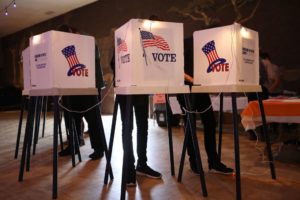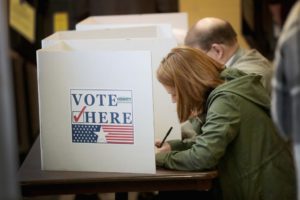-
Elections
- Voting in America: A Right with Rules – Lesson
- Winning the Presidency Isn’t as Easy as it Might Sound – Lesson
- Winning the Presidency Isn’t as Easy as it Might Sound – Quiz
- The Primary and Caucus Process – Lesson
- The Primary and Caucus Process – Quiz
- Super Tuesday: The Biggest Day in Primary Voting – Lesson
- Super Tuesday: The Biggest Day in Primary Voting – Quiz
- Delegates and Superdelegates – What are They? – Lesson
- Delegates and Superdelegates – What are They? – Quiz
- The Importance of Political National Conventions – Lesson
- The Importance of Political National Conventions – Quiz
- Political Spending: Does More Money Mean More Votes? – Lesson
- Political Spending: Does More Money Mean More Votes? – Quiz
- Who Donates to Politicians? – Lesson
- Who Donates to Politicians? – Quiz
- How Economics Has Shaped Elections – Lesson
- Presidential Debates: What Is the Moderator’s Job? – Lesson
- How Does the Electoral College Work? – Lesson
- How Does the Electoral College Work? – Quiz
- Why the Electoral College is Important – Lesson – VIDEO
- Why the Electoral College is Important – Quiz
- Campaign Money: Where Does It Go After Election Day? – Lesson
- Campaign Money: Where Does It Go After Election Day? – Quiz
- ‘Shaping’ the Nation: Is It Redistricting or Gerrymandering? – Lesson
- ‘Shaping’ the Nation: Is It Redistricting or Gerrymandering? – Quiz
- It’s Primary Season in the United States – Lesson
- It’s Primary Season in the United States – Quiz
- Which Way the Wind Blows: Straw Polls and US Elections – Lesson
- Which Way the Wind Blows: Straw Polls and US Elections – Quiz
It’s Primary Season in the United States – Lesson

(Photo by Scott Olson/Getty Images)
Primary votes are a way to whittle down the candidates who will compete in the general election.
It’s an election year in the United States, and the two main political parties are already preparing. In November, Americans will be voting on politicians to represent them in Congress, as well as various state offices, including governors. Each state is different – this time, 36 states will be voting on governors, while 35 Senate seats are up for grabs, and all 435 voting seats in the House of Representatives need to be voted upon.
Even though the election isn’t until November, voting has already begun in primaries. These are votes to decide who will eventually get to compete in the final elections. Primary season started in early May with Indiana and Ohio, but several other states have already followed with their own primary races.
So, how do primary races work, and what impact will they have on the final election in November?
A Primer on Primaries

Doug Mastriano (Photo by Michael M. Santiago/Getty Images)
If you have ever watched the television reality show Survivor, you already know how American political primaries work. As in the TV show, contestants (politicians) are divided into two teams: In political “survivor,” those teams are the two major parties, Republicans and Democrats. A series of challenges or tests then whittle away the weaker from stronger candidates. Little by little, the field is narrowed, and top candidates then go to a vote within their own party. That’s the primary. The winners then face off in a general election to decide who gets booted off the island – or wins a job representing the American people.
For example, let’s take the recent primary race for governor of Pennsylvania.
On the Republican “team,” nine people competed against each other for the chance to represent the party in the November election. The winner was Doug Mastriano, who got the most votes for a Republican.
On the Democrat team, there was only one competitor: Josh Shapiro. Of course, he got 100% of the votes.
Thanks to those primary votes, we know that in November, Mastriano and Shapiro will face off as the competitors for each major political party.

Types of Primaries
There are three types of primaries: Closed, open, and semi-open. Each state determines which contests will be allowed on voting day.
Open Primary
An open primary allows any registered voter to choose any person on the ballot. It doesn’t matter if you are a Democrat who wishes to vote for a Republican, Independent, or Green Party candidate. There are 15 states that allow crossover voting: Alabama, Arkansas, Georgia, Hawai’i, Michigan, Minnesota, Mississippi, Missouri, Montana, North Dakota, South Carolina, Texas, Vermont, Virginia, and Wisconsin. As a general rule, states that have open primaries don’t make people choose a certain party when they register to vote.
Closed Primary

(Photo by Mario Tama/Getty Images)
In a closed primary, voters can only vote for a candidate in the same party they belong to as a registered member. Only nine states have a closed primary: Delaware, Florida, Kentucky, Maryland, Nevada, New Mexico, New York, Oregon, and Pennsylvania.
Other Primaries
There are 26 states with some sort of mishmash between open and closed primaries. This system varies from state to state.
Getting Ready for the Big Show
Whether you live in a state with an open, closed, or a combination primary system, every citizen of the US has the right to cast a vote in our representative form of government. Primary season is a time when voters can prepare for an election, get familiar with the candidates and issues, and choose who they want to compete in the final race. Some might say helping to determine which candidates make it to the general election is one of the most important decisions to make during a lifetime.